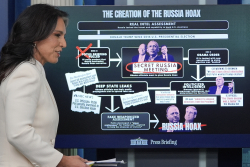The Syrian interim government must grant more autonomy to minority groups if it wants to survive and succeed.
Post-conflict transitions are notoriously difficult for societies that have experienced a long-running civil war—a reality Syria and Syrians are unfortunately learning firsthand today. Following days of sectarian fighting that threw the country’s south into chaos, many are once again questioning the capabilities and interests of the new interim authorities in Damascus. Concerns surrounding the interim authorities are far from promising for the future, suggesting that reasonable pressure from world leaders and significant policy adjustments on the part of the Syrian government are necessary to right the ship.
Fortunately, the situation in Syria’s Suweida Governorate—where fighting erupted between the Druze and the nomadic Sunni Arab Bedouins—has largely subsided. The parties agreed to a ceasefire on July 20, with Damascus’s internal security forces overseeing the withdrawal of Bedouin fighters, controlling entry into the governorate, and introducing some forces to handle local security alongside Druze factions.
The Druze constitute the largest ethnic group in the governorate, and roughly 3 percent of Syria’s total population. Both the Druze and the Bedouin communities are prominent in Suweida, and they have a history of both peace and conflict. The instability reportedly displaced at least 93,000 civilians from both communities and caused a humanitarian crisis.
Indeed, that the violence ended unfortunately marks the only positive news from these developments. With official figures still being verified, it appears that hundreds likely died, including women, children, and the elderly. Major factions on each side likely committed human rights violations, with some fighters posting their acts online. No party can claim the moral high ground.
Bad actors and spoilers worsened efforts to stop the fighting and control the situation. Syria is second to none when it comes to the disinformation space, possibly outside of Ukraine. That dynamic reared its ugly face again, with blatant influence campaigns pushing sectarianism across social media and driving more fighters to enter the fray, especially from Syria’s Sunni Arab tribal components.
The reality is that, with Assad gone, major political and military blocs are assessing the field to ensure their camp secures the best possible outcome. For Syria’s minorities, that means survival amid a Sunni Arab majority they feel they cannot trust. Painful, traumatic experience informs that stance, just as it does Syria’s new leaders and a majority of Syria’s Sunni Arab population that supports them. The difference is that the latter group feels vindicated in their victory in the war and expects that the state they now run will have centralized control over the country.
In this context, Suweida’s violence should unfortunately not come as a surprise. The country has been divided for years because of conflict—those divisions have only hardened over time. The Assad regime instilled distrust for decades in a classic authoritarian divide-and-conquer approach to its rule. That is not to say that Syrians are not proud of their diversity. Rather, the results of a totalitarian governance model did not simply fade away with former President Bashar al-Assad’s defeat in December 2024.
After nearly fourteen years of fighting, it is understandable that the country’s various leaders and factions are not immediately uniting. But this dynamic must change for Syria to recover and experience a successful post-conflict transition. That will require serious give-and-take on the part of all parties.
Ultimately, the buck stops with Syria’s leader: Interim President Ahmed al-Shara. While it is understandable and even reasonable for him to demand central government control of the whole country, his approach matters. A suit, a tie, and a few nice words are not enough to immediately build trust with Syria’s mosaic of ethnic and religious groups. Al-Shara will have to show good faith rather than distrust in these groups. He cannot repeat the Assad model—namely, the application of massive force to induce capitulation—on a national scale.
Alternatively, al-Shara should work with Syria’s leading ethnic minorities by allowing them control over local security dynamics. His government should rein in Sunni Arab factions, including and especially those now enmeshed in the armed forces. This approach will take care and skill, as there is a reason al-Shara has been unable to fully commit to transitional justice efforts that would implicate these factions.
Many former Sunni Arab factions entered the new Syrian Army as entire blocs. They include the US-sanctioned Suleiman Shah Brigade and the Hamza Division, which are brutal, radical, and uncontrollable. Indeed, they pose the greatest threat to the interim government, not the minority groups that previously relied on the Assad regime’s fleeting and fake “protection.” Al-Shara cannot check their power or hold them accountable for their brutality today without risking an uprising. He lacks the manpower and legitimacy.
The problem, however, is that al-Shara also fears Syria’s balkanization if ethnic minority factions pull away. This concern is more than valid, with countries like Israel and Iran eager to chew off any part of Syria for their regional schemes. But he should view these groups as potential allies that can help him balance the power of Sunni Arab factions. Indeed, by doing so, he can simultaneously undercut former regime elements and spoilers looking to weaken Syria’s transition.
Still, any such shift will require a leap of faith, allowing minority factions to join the military as whole blocs, just like the Sunni Arab groups. That leap of faith is exactly the step needed to garner trust from Syria’s minorities and counter the primary threat to his power. From there, he can conduct a proper transitional justice campaign that shows Syrians his seriousness about a new Syria and not more of the same nightmare that has plagued the country for decades.
Without intervening too heavily, regional and international states can help al-Shara rebalance Syria’s security situation. They have an interest in doing so, given the dire state of the Middle East’s geopolitics and the importance of Syrian stability to a calmer region.
Qatar’s ties to the Sunni Arab factions, built over years of paying their salaries and providing arms, can help rein in the factions that have been impossible to control. The United States can offer additional economic incentives, including further sanctions relief, further removal from the State Sponsors of Terrorism list, and a full revocation of the Caesar Act. Washington can also induce major minority factions, including and specifically the Syrian Democratic Forces, to meet al-Shara halfway in their negotiations to bring northeast Syria back into Damascus’ fold. US Special Envoy Thomas Barrack appears to already be working the diplomatic channels with this goal in mind.
To be clear: the Trump administration must not adopt an overly prescriptive policy of nation-building. Such an approach has failed miserably in the past and is an anathema to its worldview. Yet, if Washington views Syria’s transition as essential to its regional policy—and it increasingly looks like it does—it should continue to match the Syria file and its engagements with the al-Shara government with its interests. That means supporting the interim authority through the transition in ways that help it succeed, in support of the primary and long-running goal of a military withdrawal.
About the Author: Alexander Langlois
Alexander Langlois is a foreign policy analyst and Contributing Fellow at Defense Priorities. He is focused on the geopolitics of the Levant and the broader dynamics of West Asia. Langlois holds a Master of Arts degree in International Affairs from American University. He has written for various outlets such as The Carnegie Endowment for International Peace’s Sada, Atlantic Council’s MENASource, the Lowy Institute, Gulf International Forum, the New Arab, the Nation, and Inkstick. Follow him on X: @langloisajl.
Image: Mohammed Bash / Shutterstock.com.

















